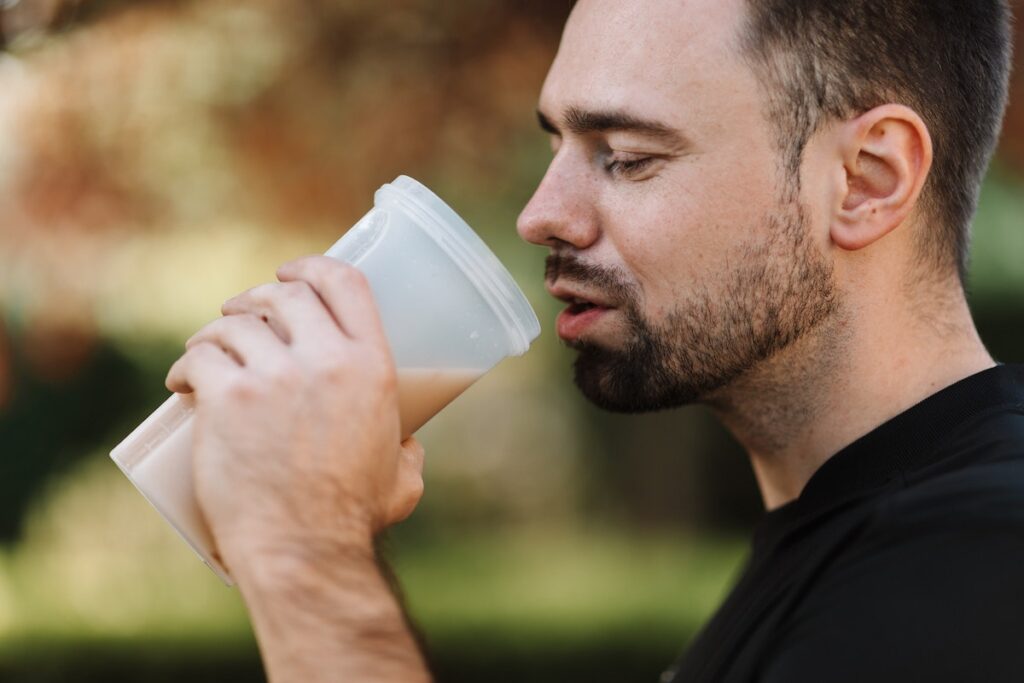Finding the ideal milk for your protein shake can seem challenging given the various options like cow’s milk, soy, or almond milk, each with unique nutritional profiles. The choice can greatly influence the shake’s nutrition, taste, and texture. Some milk may suit certain dietary needs or health goals more than others, for example, lactose-free alternatives for lactose intolerant individuals.
In this article

Eight best milk options for protein shakes
Looking to whip up a protein shake that’ll make your taste buds dance? Well, look no further, because here are the top milk options for protein shakes that will have you sipping and smiling in no time. Get ready to blend up some creamy goodness!
1. Skim Milk
This low-fat dairy option keeps protein shakes creamy while minimizing fat content.
2. Almond Milk
A plant-based option that enhances the consistency of protein shakes without the extra calories found in cow’s milk.
3. Soy Milk
Known for being a high-protein, plant-based milk, soy milk is a good choice for those looking to enhance their protein intake.
4. Reduced-Fat Milk
Similar to skim milk, this is another low-fat dairy option for those who prefer a creamier texture without the high-fat content.
5. Pea Milk and Hemp Milk
Plant-based alternatives offer complete protein sources, making them excellent choices for vegetarians and vegans.
6. Oat Milk
A lactose-free option with a creamy texture that’s slightly sweet, also offering a good amount of fiber.
7. Whole Milk
For those not concerned about fat content, whole milk offers a rich, creamy texture and high protein content.
8. Goat Milk
Another high-protein option that some people may find easier to digest than cow’s milk.
The milk you pick can totally transform the flavor, consistency, and nutritional punch of your protein shake. So how do you choose the right milk for your protein shake? Let’s discuss the factors to consider.
What should you consider when choosing milk for protein shakes?
Alright, let’s talk about how to pick the right milk for your protein shake. Here are some tips and points to keep in mind:

- Protein Content: If your main goal is to increase your protein intake, cow’s milk (including whole, skim, and low-fat) is generally higher in protein than most plant-based milk. However, soy milk is a plant-based option that contains a comparable amount of protein.
- Dietary Restrictions: If you’re lactose intolerant, allergic to dairy, or following a vegan diet, plant-based milk like almond, soy, or oat milk would be suitable options. Remember, though, that the protein content in most plant-based milk (except for soy) is generally lower than in cow’s milk.
- Calories and Fat: If you’re watching your caloric intake or trying to lose weight, consider low-fat or skim cow’s milk, or unsweetened plant-based milk. Almond milk, for instance, is typically lower in calories than cow’s milk. However, if you’re trying to gain weight or muscle, whole milk or higher-calorie plant-based milk like coconut milk might be a good fit.
- Taste and Texture: The taste and texture of the milk can significantly impact the overall flavor of your protein shake. Some people find that the creaminess of whole milk or oat milk enhances their protein shake, while others prefer the light, nutty flavor of almond milk.
- Added Sugars: Be mindful of the sugar content in your milk, especially if you’re watching your sugar intake. Many plant-based milks come in sweetened versions, which can add a significant amount of sugar to your shake. Opt for unsweetened varieties when possible.
- Other Nutrients: Consider other nutritional needs. For instance, if you’re looking for a good source of omega-3 fatty acids, flax milk could be a good choice. If you’re looking to increase your calcium intake, fortified plant-based milk can be a good option.
What are some lactose Intolerance and milk alternatives?
Got a love-hate relationship with Dairy? Don’t worry, lactose intolerance won’t keep you from enjoying delicious protein shakes. Here are 5 milk alternatives for protein shakes that’ll keep your taste buds singing and your tummy happy.
1. Lactose-Free Milk
This is regular cow’s milk with the lactose already broken down, typically by adding the enzyme lactase. It has a similar nutritional profile to regular milk, including protein, calcium, and vitamin D content.
2. Soy Milk
Made from soybeans, soy milk is naturally lactose-free and is close to cow’s milk in terms of protein content. Some brands are fortified with calcium and vitamin D.
3. Almond Milk
Made from ground almonds and water, almond milk is naturally lactose-free. It’s generally lower in calories and protein than cow’s milk and soy milk but does not naturally contain much calcium or vitamin D, so it’s often fortified.
4. Oat Milk
Made from oats and water, oat milk is also naturally lactose-free. It has a creamy texture that’s similar to cow’s milk but is generally lower in protein. Some brands are fortified with calcium and vitamin D.
5. Rice Milk
Made from milled rice and water, rice milk is naturally lactose-free and is the least allergenic of the milk alternatives. However, it’s low in protein and not naturally high in calcium or vitamin D, so it’s often fortified.
When choosing a milk alternative, it’s important to read the nutrition label carefully. Some products may contain added sugars or other additives. So, go for the unsweetened versions whenever you can, and if you’re after some calcium and vitamin D goodness, make sure your milk alternative is fortified with those nutrients.
Frequently asked questions (FAQ)
Got more questions about the best milk for protein shakes? Check out some commonly asked questions about this topic below.
What are the nutritional differences between cow’s milk, soy milk, and almond milk?
Cow milk has a higher protein content compared to soy and almond milk. However, soy milk is a good plant-based alternative that also provides a decent amount of protein. Almond milk is lower in protein but is a low-calorie option that can be great for those watching their caloric intake.
How does the choice of milk affect the taste and texture of a protein shake?
The type of milk you choose can significantly impact the taste and texture of your protein shake. Cow’s milk tends to yield a creamier and thicker shake, while soy milk and almond milk result in a slightly thinner consistency. The taste will also vary, with each type of milk offering its unique flavor.
Are there suitable milk alternatives for lactose-intolerant individuals wanting to make protein shakes?
Absolutely, there are several alternatives to cow’s milk for those who are lactose intolerant or prefer plant-based options. Soy milk, almond milk, oat milk, and other non-dairy milk can be used in protein shakes. These alternatives still provide nutritional value and can be a great addition to your shake.
Final Word
Are you a fan of protein-packed cow’s milk or do you lean towards plant-based alternatives like soy or almond milk? Well, good news! Each of them brings its own nutritional perks and tasty flavors to the table, making your protein shake both delicious and nourishing. And hey, if you’re lactose intolerant, don’t worry! There are plenty of lactose-free options out there too.
If this guide helped, why not share it with a friend? And for more awesome fitness and nutrition tips, check out our full blog. Your health and fitness goals are just one shake away!
